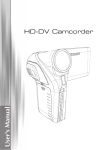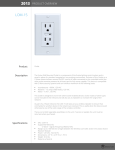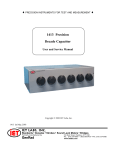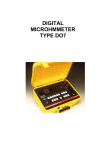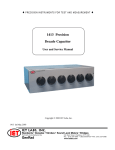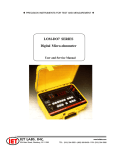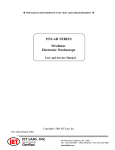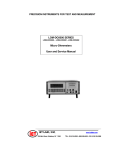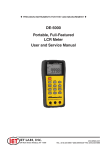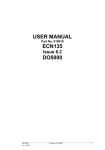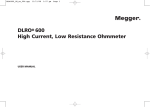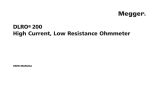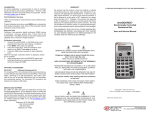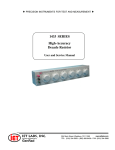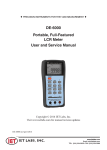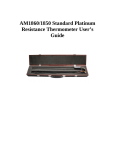Download LOM-4000/4001 Manual
Transcript
♦ PRECISION INSTRUMENTS FOR TEST AND MEASUREMENT ♦ LOM-4000 SERIES Digital Ohmmeter User and Service Manual Copyright © 2005 IET Labs, Inc. LOM-4000 im February, 2005 IET LABS, INC. Standards • Decades • Strobes • Sound Level Meters • Bridges 534 Main Street, Westbury, NY 11590 www.ietlabs.com TEL: (516) 334-5959 • (800) 899-8438 • FAX: (516) 334-5988 WARRANTY We warrant that this product is free from defects in material and workmanship and, when properly used, will perform in accordance with applicable IET specifications. If within one year after original shipment, it is found not to meet this standard, it will be repaired or, at the option of IET, replaced at no charge when returned to IET. Changes in this product not approved by IET or application of voltages or currents greater than those allowed by the specifications shall void this warranty. IET shall not be liable for any indirect, special, or consequential damages, even if notice has been given to the possibility of such damages. THIS WARRANTY IS IN LIEU OF ALL OTHER WARRANTIES, EXPRESSED OR IMPLIED, INCLUDING BUT NOT LIMITED TO, ANY IMPLIED WARRANTY OF MERCHANTIBILITY OR FITNESS FOR ANY PARTICULAR PURPOSE. iii WARNING OBSERVE ALL SAFETY RULES WHEN WORKING WITH HIGH VOLTAGES OR LINE VOLTAGES. Dangerous voltages may be present inside this instrument. Do not open the case Refer servicing to qulified personnel HIGH VOLTAGES MAY BE PRESENT AT THE TERMINALS OF THIS INSTRUMENT WHENEVER HAZARDOUS VOLTAGES (> 45 V) ARE USED, TAKE ALL MEASURES TO AVOID ACCIDENTAL CONTACT WITH ANY LIVE COMPONENTS. USE MAXIMUM INSULATION AND MINIMIZE THE USE OF BARE CONDUCTORS WHEN USING THIS INSTRUMENT. Use extreme caution when working with bare conductors or bus bars. WHEN WORKING WITH HIGH VOLTAGES, POST WARNING SIGNS AND KEEP UNREQUIRED PERSONNEL SAFELY AWAY. CAUTION DO NOT APPLY ANY VOLTAGES OR CURRENTS TO THE TERMINALS OF THIS INSTRUMENT IN EXCESS OF THE MAXIMUM LIMITS INDICATED ON THE FRONT PANEL OR THE OPERATING GUIDE LABEL. vii Contents Chapter 1 INTRODUCTION ..................................................................................................................................... 1 1.1 General Description ........................................................................................................................ 1 1.2 Theory of Operation ........................................................................................................................ 1 1.3 Case Design .................................................................................................................................... 1 1.4 Available Accessories ..................................................................................................................... 1 Chapter2 SPECIFICATIONS .................................................................................................................................... 2 2.1 General: ........................................................................................................................................... 2 2.2 Measurement: ................................................................................................................................. 2 Chapter 3 OPERATION .............................................................................................................................................. 3 3.1 Initial Inspection ............................................................................................................................. 5 3.2. Safety ............................................................................................................................................ 5 3.3 Features ......................................................................................................................................... 5 3.3.1 Measurement Polarity ........................................................................................................... 5 3.3.2 Range Selection: ................................................................................................................... 5 3.3.3 Error & Status Lamps .......................................................................................................... 5 3.4 Making Measurements ................................................................................................................. 5 3.4.1 Ohmmeter Connections ........................................................................................................ 5 3.4.2 Start-up ................................................................................................................................. 6 3.4.3 Measurement ......................................................................................................................... 6 3.4.4 Current Mode ......................................................................................................................... 7 3.4.5 Over-Range .......................................................................................................................... 7 3.4.6 Open-Circuit Lead ................................................................................................................ 8 3.4.7 Low Battery .......................................................................................................................... 8 3.4.8 Connections........................................................................................................................... 8 3.5 Protection ....................................................................................................................................... 8 3.6 Temperature Compensation (Model LOM-4001 Only) .................................................................. 8 3.7 Temperature Measurement (Model LOM-4001 Only .................................................................... 8 Chapter 4 CALIBRATION ......................................................................................................................................... 9 4.1 Calibration Process ......................................................................................................................... 9 4.2 Equipment Required ........................................................................................................................ 9 4.3 Preparation ...................................................................................................................................... 9 4.4 Calibration Using MTS2 Standard .................................................................................................. 9 4.4.2 Entering a password, and Calibration ..................................................................................... 9 4.5 Calibration Using Discrete Resistance Standards ........................................................................... 9 Chapter 5 MAINTENANCE ..................................................................................................................................... 11 5.1 General ......................................................................................................................................... 11 Figures Figure 3.2 Combined current and potential probes (Kelvin clips) ....................................................................... 6 Figure 3.3 Connections for resistance measurements with various DUT configurations .................................... 7 Figure 3.4 Connection Diagram for Pt100 plug (viewed from the rear) .............................................................. 8 LOM-4000 Series Chapter 1 INTRODUCTION 1.1 General Description 1.3 Case Design The LOM-4000 and LOM-4001 are accurate bench/ portable handheld Digital Milli-ohmmeters for the measurement of resistance in the range 10 µΩ to 4000 Ω. They utilize the four-terminal (Kelvin) resistance-measurement method to eliminate the effects of lead resistance. The measured values are displayed on a 4digit, 4000-count LED display; there is also an overflow indicator. The LOM-4001 allows temperature compensation of readings and temperature measurement if the user connects a 100-ohm platinum-resistance thermometer (PRT). The case is ruggedly constructed from ABS plastic. The front panel is a reverse-printed polycarbonate overlay with clear and unambiguous text. The batteries are housed in a removable cassette for quick and easy replacement. Simple push-button or auto-range selection of the range required makes the LOM-4000 Series easy to use. Error and status warnings are illuminated when appropriate. The unit will withstand accidental application of line voltage to the measuring terminals. 1.2 Theory of Operation The measurement is true 4-terminal, using the Kelvin principle. A stable current is produced across the resistance to be measured via the current (I) terminals, and the voltage drop across the unknown resistance Rx is measured at the voltage (U) terminals. This potential drop is then compared against the voltage drop across internal standards. The ratio of these is then converted to the resistance value of Rx and displayed in ohms on the digital display. Use of specially selected components assures high accuracy and long-term stability . 1.4 Available Accessories Supplied: 1 1 1 Set of test leads Set of alkaline batteries Operation Manual Optional Lead Sets: HSO1-P HSO2-P LSO3-P LSO4-P Duplex Handspikes with 2.5-meter leads, for Kelvin measurements of plates or buss bars Similar to HSO1-P but with 2.5meter and 15-meter leads Large Kelvin clips with 3-meter leads – accept cables and bars up to 38 mm in diameter Similar to LSO3 but with 3-meter and 15-meter leads Other Optional Accessories: CO1 1 Meter Cable-Test Fixture – Wood Base CO2 1 Meter Cable-Test Fixture – Metal Base MTS2 Calibration Standard For most efficient operation, a spare battery cassette (BP-02) is recommended. Introduction 1 LOM-4000 Series Chapter 2 SPECIFICATIONS 2.1 General: 2.2 Measurement: Digital Display: 4 digit, 0.6" high LCD, 4000 count with automatic decimal point and polarity indication; additional annunciator lamps. Resistance: True four-terminal measurement with fixed dc measuring currents Measuring time: Approximately 20 ms for normal measurement, 40 ms for average (AVE) mode Polarity: Selectable positive or negative current flow by manually reversing test leads, plus an average mode which automatically displays the average value of the positive- and negative-polarity measurements. Operating temperature range: 0 to +40°C, with maximum relative humidity of 80% Storage temperature: -20°C to +50°C Power: Five “AA” alkaline batteries supplied. Rechargeable batteries optional. Battery Life: ~12 hours Dimensions: 250 x 130 x 55 mm (9.9” x 5.1” x 2.2”) Weight: 0.8 kg (1.5 lb) Temperature Measurement: -200°C to +800°C, with user-supplied Pt100 sensor RESISTANCE Range Resolution Current Accuracy 4kΩ 1Ω 100 µA ±(0.05% Rdg +0.02% FS) 30 ppm Rdg +1 ppm FS Temperature Coefficient 400Ω 100mΩ 1 mA ±(0.05% Rdg +0.02% FS) 30 ppm Rdg +1 ppm FS 40Ω 10mΩ 10 mA ±(0.05% Rdg +0.02% FS) 30 ppm Rdg +1 ppm FS 4Ω 1 mΩ 10 mA ±(0.05% Rdg +0.03% FS) 30 ppm Rdg +4 ppm FS 400mΩ 100µΩ 10 mA ±(0.05% Rdg +0.05% FS) 30 ppm Rdg +25 ppm FS 40mΩ 10 µΩ 100 mA ±(0.05% Rdg +0.1% FS) 30 ppm Rdg +25 ppm FS TEMPERATURE Range -50...+800 °C 2 Resolution 0.1°C Accuracy ±0.2°C Specification LOM-4000 Series Chapter 3 OPERATION Display Mode LED’s (4001 only) Display Value LED (4001 only) Low Battery LED Calibration + 4000 Units Indication Function Keys Operation 3 LOM-4000 Series - !! " " # % & $$ ' !* ( + " , ! ! ! ' " !* ( ! ! () ! ! ! ! ( " ! () ! ! ( ) ! ! , ' . . ( ! . . . ' . ! * ! ! ! " /! * ! - , ! ( 0 4 ! !* (! ! ! (0 . ! " . !! ! ( , Operation LOM-4000 Series 3.1 Initial Inspection the AUTO key puts the instrument into the auto-range mode. After unpacking, inspect unit for shipping damage and report any problem immediately to the carrier, retaining packaging materials for inspection. 3.3.3 Error & Status Lamps 3.2. Safety This unit has been designed and tested in accordance with IEC Standard EN61010-1, entitled "Safety Requirements for Electronic Measuring Apparatus", and has been supplied in a safe condition. This instruction manual contains information and warnings which should be followed by the user to ensure safe operation and to keep the unit in safe condition. The following LEDs will light to indicate the instrument status: CAL: Instrument is in the calibration mode. LOBAT: Battery capacity is nearly depleted. (The following LED’s are for LOM-4001 only) Rx: 3.3 Features 3.3.1 Measurement Polarity The user can reverse the measuring-current polarity by reversing the test leads. This is particularly useful when evaluating circuits with thermal emf, or circuits where diode effects can influence the measurement. For measurements where thermal emf can cause a large zero-error, there is an automatic-average (AVE) button. When it is pressed, the measuring current will automatically be reversed and the average value displayed, thus eliminating the need for external computations. This averaging feature also doubles the measurement time from 20 ms to 40 ms. The AVE lamp will light to indicate that the current polarity is changing. 3.3.2 Range Selection: Any of the six measuring ranges can be selected manually by simply pressing the desired RANGE UP or DOWN buttons. Over-range is indicated by the display reading “- - - -“. An auto-range capability is also provided: pressing Operation The display shows a resistance reading. Rc: The display shows a compensated resistance reading. °C: The display shows a temperature reading. 3.4 Making Measurements 3.4.1 Ohmmeter Connections The LOM-D4000/1 employ a four-wire method of measurement, i.e. four connections to the resistor under test are required. The unit is supplied with four leads: two voltage leads to be placed across the exact measurement points, and two current leads to be placed “outside” the measurement points. The Kelvin clips, shown in Figure 3.2, place voltage and current connections at the same point. a) Connect the red leads to the +I and +U terminals, and the black leads to the –I and –U terminals. b) Clip the test leads onto the resistor under test. Cleanliness is important; if the DUT is not clean, clean it with fine emery cloth or steel wool to remove oxides. 5 LOM-4000 Series c) It is not always possible to use the combined current and potential (Kelvin) clips, in which case test leads with spade lugs—or a special test fixture - may have to be made for a particular application. d) Fig. 3.3 illustrates connections to various types of test resistors e) When measuring 4-terminal resistance standards, or using them for calibration, the Kelvin clips may not be usable because of terminal geometry. Make four separate connections to the current and potential terminals 3.4.2 Start-up Fig. 3.2 Combined current and potential probes (Kelvin clips) When the LOM-DO7e is first switched on, an internal self-test is automatically performed. The display indicates +8888 followed by PASS, then performs an automatic zero sequence and finally sets to the 4 kΩ range. The unit is now ready to make measurements. The unit will shut off automatically after several minutes of inactivity. If the internal checks indicate an error, the display will read FAIL. Contact our Service Department or your IET Representative for assistance. 3.4.3 Measurement Connect the resistance to be measured (Rx) to the measuring terminals in accordance with the diagram on the instrument panel and using the most appropriate connection technique for the unknown (See Figs. 3.2 and 3.3). Select the range required or AUTO, and the AVE measurement mode if desired (The AVE button LED will light to indicate that the AVE functions is active. To initialize the measurement, press the MEAS button. A single measurement will be taken and the value held on the display. To take continuous readings, press and hold the MEAS button until a long beep is heard; this will activate a continuousreading mode. 6 Operation LOM-4000 Series Fig. 3.3 Connections for resistance measurements with various DUT configurations Measurements will continue until the MEAS key is pressed again. To preserve battery life, the unit will automatically turn off after several minutes of inactivity. with the current flowing in both directions and displays the average of the two readings. The AVE mode should not be used for measurement of inductive circuits. 3.4.5 Over-Range 3.4.4 Current Mode The current mode can be set to AVE. The AVE mode may be selected for measurements that are not inductive, in order to eliminate errors caused by thermal emf in the measurement circuit or test leads. In the AVE mode the LOM-D4000/1 takes readings Operation If the measured value exceeds the upper limit of the range selected, the display will indicate “- - - -“. Select a higher range. In AUTO mode, this display indicates a value above the range of the instrument. 7 LOM-4000 Series 3.4.6 Open-Circuit Lead If one of the test leads is open-circuited, or exceeds a preset resistance, the display will indicate “OC“. (The I terminals are checked for compliance voltage). Measurements cannot be made if this warning message is displayed. This warning will also be displayed if the current-lead resistance is high. 3.4.7 Low Battery The LOBAT LED will light when the battery has ~10% charge remaining. When this occurs, a spare battery cassette should be installed, or the existing cassette should be resupplied with fresh--or recharged-batteries. Full measurement accuracy is maintained even when the LOBAT LED is lit. 3.4.8 Connections To make the most accurate possible measurements, ensure that all test leads are in good condition, and have less than 0.2 Ω resistance. Some spade lugs and alligator clips - especially nickel-plated brass types - can produce high thermal emf’s when heated. This can sometimes cause problems , for example when connecting to hot motor windings. Avoid such problems by using plain copper or brass connections and keeping them clean and oxide-free. 3.5 Protection This instrument is protected against voltages being applied inadvertently to the terminals. A high-interrupting-capacity fuse is installed internally in the current circuit. The voltage terminals are not fused, and will withstand up to 460 Volts without damage to the .instrument. To replace the protection fuse, the unit should be opened by removing the six screws on the bottom of the case,, but only after ac power and all input connections are removed. The protection fuse is located on the printed circuit board. This fuse has a 40,000to-200,000 A interrupting capacity, depending on the 8 exact type used. Always replace this fuse with one of the same current rating (1 A) and at least a 40,000 A interrupting capacity. 3.6 Temperature Compensation (Model LOM-4001 Only) Automatic temperature compensation is available on the model LOM-4001. A Pt100 temperature sensor should be connected to the DIN socket next to the measuring terminals. To activate this function press the DISP key the Rc LED will light to show that the displayed value is the compensated resistance. The Pt100 sensor will measure the ambient temperature and compensate the reading for the temperature coefficient of the measured Rx. Different temperature coefficients may be selected by pressing the COMP key, Copper and aluminium coefficients are preset; a user coefficient may also be entered. Repeated pressing of the COMP key cycles through these options. To set the user coefficients the arrow keys are used select and increment or decrement the digits. 3.7 Temperature Measurement (Model LOM-4001 Only The model LOM-4001 can also be used as thermometer using a Pt100 temperature probe inserted into the socket next to the measuring terminals. Press the DISP key until the °C LED lights. The LOM-4001 will now display the temperature measured by the Pt100 sensor. +I -I +U -U GROUND Fig. 3.4 Connection Diagram for Pt100 plug (viewed from the rear) Operation LOM-4000 Series Chapter 4 CALIBRATION 4.1 Calibration Process This procedure describes the standard calibration method for the LOM-4000/1 Micro-ohmmeter using the IET MTS2 Calibration Standard, or a method using discrete resistance standards of the required values. CAUTION The LOM-4000/1 comes factory-calibrated to its full accuracy, and any recalibration by the user will invalidate this initial calibration. The user should therefore be certain that only authorized and competent personnel are permitted access to the calibration process, which is password-protected. 4.2 Equipment Required IET Calibration Standard MTS2, or equivalent 4-terminal standard/s. 4.3 Preparation 4.3.1 Place the instrument in a temperature-controlled environment (20°C ±5°C) for a minimum of 2 hours. Ensure that the batteries are fresh or fully charged. 4.4 Calibration Using MTS2 Standard 4.4.1 Connect each of the four LOM-4000/1 terminals to the equivalent terminals on the calibration standard. Calibration 4.4.2 Entering a password, and Calibration 1. Turn the LOM-4000/1 on while holding down the CAL key. The display will show CODE for a few seconds and the 0000 with a flashing cursor under the first zero. Enter the calibration code 9252 using the UP and DOWN keys to select the digits and the ZERO and AVE keys (with the left-and-right arrows) to select the position. When done, press the MEAS (OK) key. When the entry has been validated, the instrument enters the calibration mode and the CAL LED illuminates. 2. The display will now show 0.0, with the first digit flashing. Set the MTS2 to zero and press OK. This calibrates the zero on the first range. The display will then show the full-scale reading on that range (4.000) with the first digit flashing. Set the MTS2 to the same value, and (if desired for better accuracy) enter the exact calibrated value for that MTS2 setting using the arrow keys as above. The press OK. 3. The calibration process then switches automatically to the next range. Proceed as above until all ranges are calibrated. Then press the CAL button to exit the calibration mode. 4.5 Calibration Using Discrete Resistance Standards 4.5.1 Discrete, 4-terminal resistance standards may be used in place of the MTS2 Calibration Standard. The standards must have an uncertainty better than 0.01% if full calibration accuracy is to be achieved. The following nominal standards are recommended: 4 kΩ 400 Ω, 40 Ω, 4 Ω, 400 mΩ, 40 mΩ and 4 mΩ. 9 LOM-4000 Series 4.5.2 4.5.4 In all measurements the U + and - and the I + and - terminals are connected to the equivalent terminals (usually marked “Sense” and “Current”) on the fourterminal standards used. Use the procedure of 4.4.1 above to perform the calibration using discrete standards. Replace the zero setting and resistance values of the MTS2 with the shorting procedure above and the discrete resistance standards to be used. 4.5.3 For the ZERO measurement, short the “Sense” terminals of the standard connected to the instrument, using the shorting clip supplied with the standard, or a heavy wire. All four leads between the instrument and the standard should remain connected. Remove the short after the ZERO calibration is completed. 10 Calibration LOM-4000 Series Chapter 5 MAINTENANCE 5.1 General ! CAUTION ! Normally no maintenance is required other than cleaning with a moist cloth. Avoid strong detergents or solvents. Replace only with the correct fuse type shown below, or an equivalent part with the same or higher interrupting capacity: If a failure occurs, or if the unit cannot be calibrated, it should be returned to IET or to an IET representative. Contact IET for an RMA number before returning the unit directly to IET. NFC 63210, Altech 1C10x38G1 or Cooper Bussman KTK-1 CAUTION: Replace only with the correct fuse type shown below. The input circuits are protected by a 1 A fuse located in a holder on the printed circuit board. Open the case by removing the six screws holding the two sections together.. Examine the fuse and replace if necessary. Maintenance 11

















